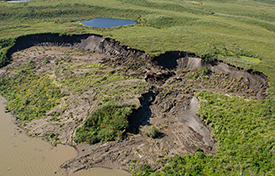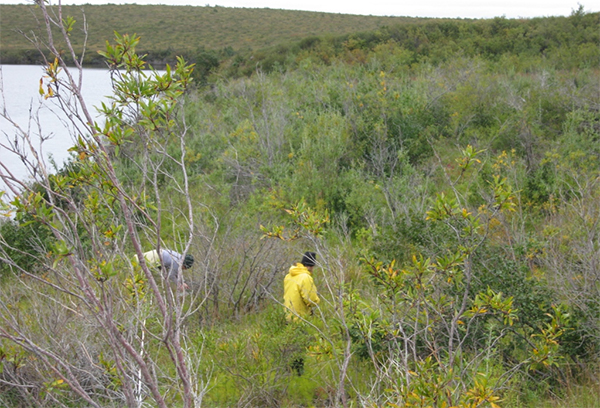
Retrogressive thaw slump near Holmes Creek. Photo by Trevor Lantz.

Massive retrogressive thaw slump on the Peel Plateau. Photo by Trevor Lantz.

Retrogressive thaw slump in the Mackenzie Delta Uplands. Photo by Trevor Lantz.

Retrogressive thaw slump in the Mackenzie Delta Uplands. Photo by Trevor Lantz.
References
Kokelj S.V., Jenkins R.E.L., Milburn D., Burn C.R., Snow N. (2005). The influence of thermokarst disturbance on the water quality of small upland lakes, Mackenzie Delta Region, Northwest Territories, Canada. Permafrost and Periglacial Processes 16: 343-353. PDF
Kokelj S.V., Lantz T.C., Kanigan J., Smith S.S., Coutts R. (2009). Origin and polycyclic behavior of tundra thaw slumps, Mackenzie Delta Region, Northwest Territories, Canada. Permafrost and Periglacial Processes, 20(2):173-184. doi:10.1002/ppp.642. PDF
Kokelj S.V., Smith C.A.S., Burn C.R. (2002). Physical and chemical characteristics of the active layer and permafrost, Herschel Island, western arctic coast, Canada. Permafrost and Periglacial Processes 13: 171-185. PDF
Kokelj S.V., Zajdlik B., Thompson M.S., Jenkins R.E.L. (2008). Thawing permafrost and temporal variation in the electrical conductivity of small tundra lakes, Mackenzie Delta region, N.W.T., Canada. In Proceedings of the Ninth International Conference on Permafrost. Institute of Northern Engineering, University of Alaska Fairbanks (Vol 1). 965-970. PDF
Lantz T.C., Kokelj S.V. (2008). Increasing rates of retrogressive thaw slump activity in the Mackenzie Delta Region, N.W.T., Canada. Geophysical Research Letters, 35, L06502, doi:10.1029/2007GL032433. PDF
Lantz, T.C., Kokelj, S.V., Gergel, S.E. and Henry, G.H.R. (2009). Relative impacts of disturbance and temperature: persistent long-term changes in microenvironment and vegetation in retrogressive thaw slumps. Global Change Biology. 15: 1664-1675. PDF
Mesquita, P.S. (2008). Effects of Retrogressive Permafrost Thaw Slumping on Benthic Macrophyte and Invertebrate Communities of Upland Tundra Lakes. MSc. Thesis, University of Victoria. PDF
Mesquita P.S., Wrona F.J., Prowse T.D. (2008). Effects of retrogressive thaw slumps on sediment chemistry, submerged macrophyte biomass, and invertebrate abundance of upland tundra lakes. In Proceedings of the Ninth International Conference on Permafrost. Institute of Northern Engineering, University of Alaska Fairbanks (Vol 2). 1185-1190. PDF
Thompson M.S., Kokelj S.V., Wrona F.J., Prowse T.D. (2008). The impact of sediments derived from thawing permafrost on tundra lake water chemistry: An experimental approach. In Proceedings of the Ninth International Conference on Permafrost. Institute of Northern Engineering, University of Alaska Fairbanks (Vol 2). 1763-1768. PDF



